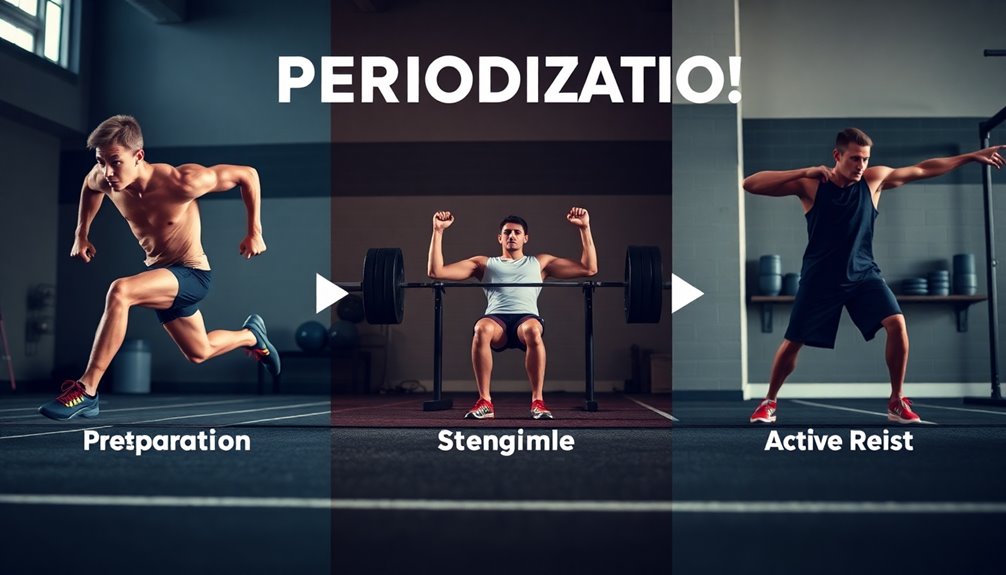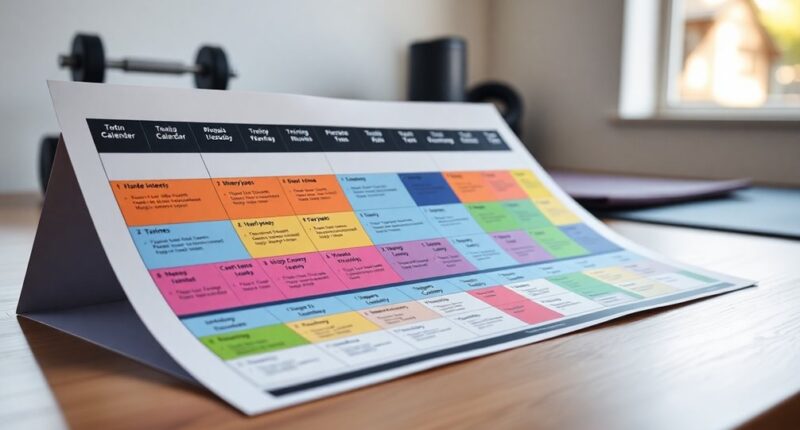Periodization in your training plan can boost your performance by up to 20% compared to traditional methods. It structures your workouts to maximize strength gains while reducing injuries. By incorporating phases focused on different goals, like building volume or intensity, you'll prevent burnout and enhance recovery. This approach also fosters mental resilience, helping you stick to long-term fitness objectives. Keep going to uncover more strategies for effectively implementing periodization in your routine.
Key Takeaways
- Periodization reduces injury risk by incorporating structured recovery periods and deloading weeks into your training plan.
- It promotes muscle adaptation and performance gains, leading to improved athletic performance.
- Athletes experience up to 20% greater strength increases compared to traditional training methods through periodization.
- The structured approach enhances mental resilience, helping athletes cope with training challenges effectively.
- Regularly monitoring progress allows for adjustments, optimizing training variables for maximum results.
Understanding Periodization Training

When you think about maximizing your training results, understanding periodization is key.
Periodization training involves strategically planning your training cycles to enhance adaptive responses while optimizing performance. By dividing your program into macrocycles, mesocycles, and microcycles, you can focus on specific goals, adjusting training volume and intensity accordingly.
This systematic variation not only promotes strength gains but also minimizes injury risk. Incorporating recovery periods and intentional deloading weeks guarantees your body adapts properly and combats overtraining. Additionally, just as nutrition is essential for brain development in children, it plays a critical role in your overall physical performance and recovery.
Whether you choose a linear or nonlinear model, periodization allows for tailored approaches that align with your needs and competition schedules. Embracing this method can transform your training experience, leading to significant improvements in overall performance optimization.
The Three Phases of Periodization

Understanding the three phases of periodization is essential for optimizing your training regimen. Each phase plays a significant role in athletic development, helping you avoid overtraining and achieve performance gains.
| Phase | Focus | Goals |
|---|---|---|
| Preparatory Phase | Higher training volume | Build a strong base through strength and conditioning. |
| Competition Phase | Increased training intensity | Peak performance with energy conservation and supercompensation. |
| Transitional Phase | Lower training volume | Facilitate recovery, preventing burnout after competition. |
Incorporating proper planning in your training can help you avoid burnout and maximize your performance during each phase.
Benefits of Periodization in Performance

When you incorporate periodization into your training, you greatly reduce the risk of injury by allowing time for recovery. This structured approach not only promotes muscle adaptation but also leads to enhanced performance gains. Additionally, mental resilience during training can further enhance your ability to cope with challenges and improve overall outcomes.
Injury Risk Reduction
Incorporating periodization into your training not only boosts performance but also considerably reduces the risk of injury. Here's how:
- Adaptations: Structured variations in training intensity allow your body to adapt gradually.
- Recovery Weeks: Planned recovery periods prevent overtraining and give muscles time to recuperate.
- Load Management: A systematic approach to load management guarantees you avoid sudden increases in stress on your body.
- Reduced Overtraining: Periodization minimizes burnout and injuries by balancing high and low-intensity phases.
Additionally, understanding the importance of emotional regulation can enhance your overall training experience by fostering a balanced mindset that supports recovery and performance.
Enhanced Performance Gains
Periodization particularly enhances your performance gains by strategically varying training loads, which optimizes muscle adaptation and strength development.
With a structured training plan, you can achieve significant strength gains and improved muscular endurance.
Athletes using periodization experience up to 20% greater increases in strength compared to traditional training methods.
The incorporation of recovery periods within this framework helps to prevent overtraining, allowing you to maintain peak performance and reduce injury risks.
By timing your training cycles effectively, you can peak at the right moment for competitive events, maximizing your overall performance.
Embracing periodization is essential for any athlete looking to elevate their game and reach new heights in their athletic journey. Additionally, implementing advanced technology in your training can further enhance efficiency and effectiveness.
How to Implement Periodization in Your Routine

To effectively implement periodization in your training routine, start by defining a macrocycle that aligns with your long-term fitness goals. Break it down into manageable mesocycles, focusing on specific objectives over 4-6 weeks.
Here's how to structure it:
- Design microcycles with varying intensity and volume throughout the week.
- Incorporate recovery phases, including taper weeks, to promote adaptation and reduce injury risk.
- Choose a periodization model—linear or undulating—based on your experience and competition schedule.
- Regularly monitor your progress and adjust training variables to guarantee each phase builds on the previous one for performance optimization. Additionally, maintaining a structured budget for your training expenses can help ensure you have the resources needed for proper equipment and recovery tools.
Common Periodization Models

When it comes to periodization models, you've got several effective options to choose from. Linear periodization offers a straightforward approach, while nonlinear periodization brings variety to your training week. Then there's block periodization, which helps you focus on specific skills for maximum gains. Additionally, understanding relationship dynamics can enhance your ability to set realistic training goals and maintain motivation.
Linear Periodization Overview
While many training approaches exist, linear periodization stands out as a systematic method that gradually ramps up intensity and reduces volume over time. This model is particularly beneficial for athletes, especially those just starting or recovering from injury.
Here's how it works:
- Hypertrophy Phase: Focus on higher repetitions with lighter weights.
- Strength Phase: Shift to lower repetitions with heavier weights.
- Power Phase: Emphasize explosive movements for peak performance.
- Recovery Phase: Allow for adaptation and prevent burnout.
Each training phase lasts about 4 to 6 weeks, optimizing adaptations and ensuring proper recovery. Additionally, incorporating stress management techniques during training can enhance overall performance and well-being.
Research shows linear periodization can lead to significant strength gains, making it a reliable choice for enhancing performance.
Nonlinear Periodization Benefits
Nonlinear periodization offers a dynamic approach to training that can greatly enhance your fitness gains. By frequently varying training intensity and volume, this method allows for better neuromuscular recovery and adaptation.
You'll experience improved strength, endurance, and body composition more effectively than with static routines. Nonlinear periodization typically alters training loads on a weekly or even daily basis, incorporating diverse training stimuli that help prevent plateaus.
This keeps you engaged and motivated, making workouts feel fresh and challenging. It's versatile, benefiting both trained and untrained individuals across different training levels and goals. Additionally, understanding hormonal fluctuations during your training can optimize your performance and recovery strategies.
Embracing nonlinear periodization could be the key to revealing your full potential and taking your fitness journey to new heights.
Block Periodization Structure
Block periodization breaks your training year into distinct phases, each targeting specific physical qualities like strength, endurance, or power to maximize your performance.
By using this training model, you can achieve significant physiological adaptations that enhance your overall capabilities. Here's how it typically works:
- Developmental blocks focus on skill and capacity building.
- Competitive blocks are designed for peak performance during key events.
- Restorative blocks allow for recovery and adaptation, preventing burnout.
- Each block lasts 2-4 weeks, enabling concentrated training efforts.
This structured approach helps eliminate competing demands, making it a preferred choice for elite athletes aiming to enhance their strength and power effectively while achieving specific training goals. Additionally, incorporating audience engagement strategies can help in maintaining motivation throughout the training process.
Tips for Staying Motivated With Periodization

Staying motivated with periodization can be a challenge, but there are effective strategies to keep your enthusiasm high.
Start by setting short-term goals that offer clear milestones to celebrate, keeping your focus sharp. Incorporate variety in workouts by cycling through strength, power, and endurance phases, which keeps things fresh and engaging.
Track your progress with measurable outcomes, like increased weights or improved race times, to reinforce a sense of achievement.
Don't forget to schedule recovery weeks; they provide essential mental breaks and prevent burnout, helping you stay committed to your long-term training goals.
Engage with a coach or a training group for accountability and support, creating a motivating environment that encourages adherence to your periodized training plan.
Frequently Asked Questions
What Are the Benefits of Periodization Training?
Periodization training offers several key benefits.
It helps you avoid training plateaus by varying intensity, volume, and exercise selection, keeping your workouts fresh and challenging.
You'll also reduce the risk of injury and overtraining by incorporating recovery periods, allowing your muscles to recover effectively.
Plus, studies show that periodization can lead to significant improvements in strength and endurance, optimizing your performance when it matters most, especially during competitions.
What Are the General Goals of Using a Periodized Training Plan?
Imagine a sculptor chiseling away at a block of marble, shaping it into a masterpiece.
That's what a periodized training plan does for your fitness. Its general goals are to enhance your strength, endurance, and overall performance by strategically adjusting intensity and volume over time.
It helps you avoid plateaus and injuries while ensuring you peak at the right moments. Plus, it keeps your training fresh and engaging, fueling your motivation to succeed.
What Are the Results of Periodization Training?
When you engage in periodization training, you're likely to notice significant improvements in both strength and endurance.
You'll experience reduced injury risk due to built-in recovery phases, allowing your muscles and joints to heal.
Plus, by continuously challenging your body, you can avoid training plateaus.
Ultimately, you'll enhance your performance outcomes, such as increased power output and better readiness for competition, making your training more effective and rewarding overall.
How Does Periodization Improve the Setting of Goals?
Periodization improves your goal setting by breaking down long-term objectives into smaller, manageable targets.
You can focus on specific goals during each training phase, keeping you motivated and engaged.
By structuring your training with clear phases, you can track your progress effectively.
This approach not only helps you avoid plateaus but also allows you to set realistic goals that align with your physical and mental well-being, reducing the risk of burnout.
Conclusion
Incorporating periodization into your training plan can seem intimidating, especially if you're used to a more spontaneous approach. But remember, it's all about structure and progress. By breaking your goals into manageable phases, you'll not only avoid burnout but also see tangible improvements in your performance. Embrace the journey, and you'll find that staying committed becomes easier. With each phase, you're one step closer to reaching your fitness aspirations! So, give it a shot—you won't regret it.









